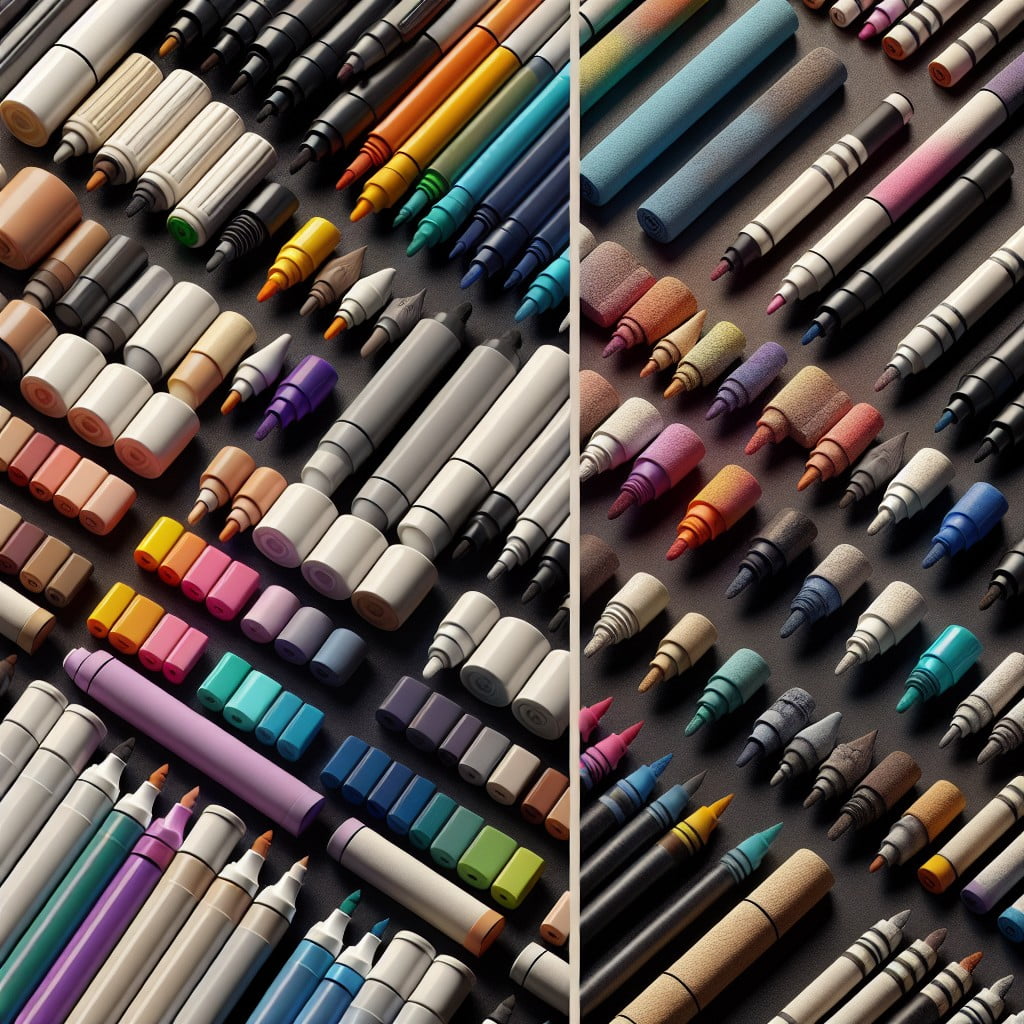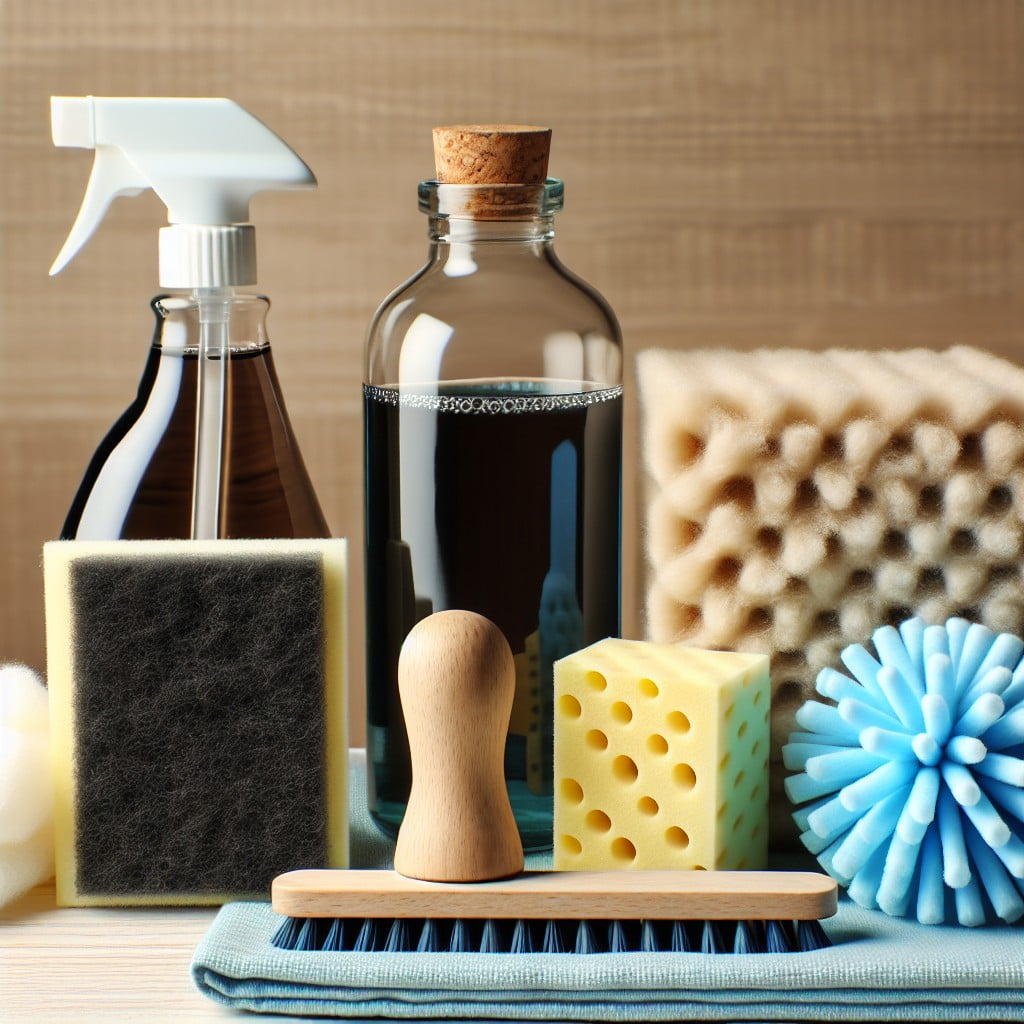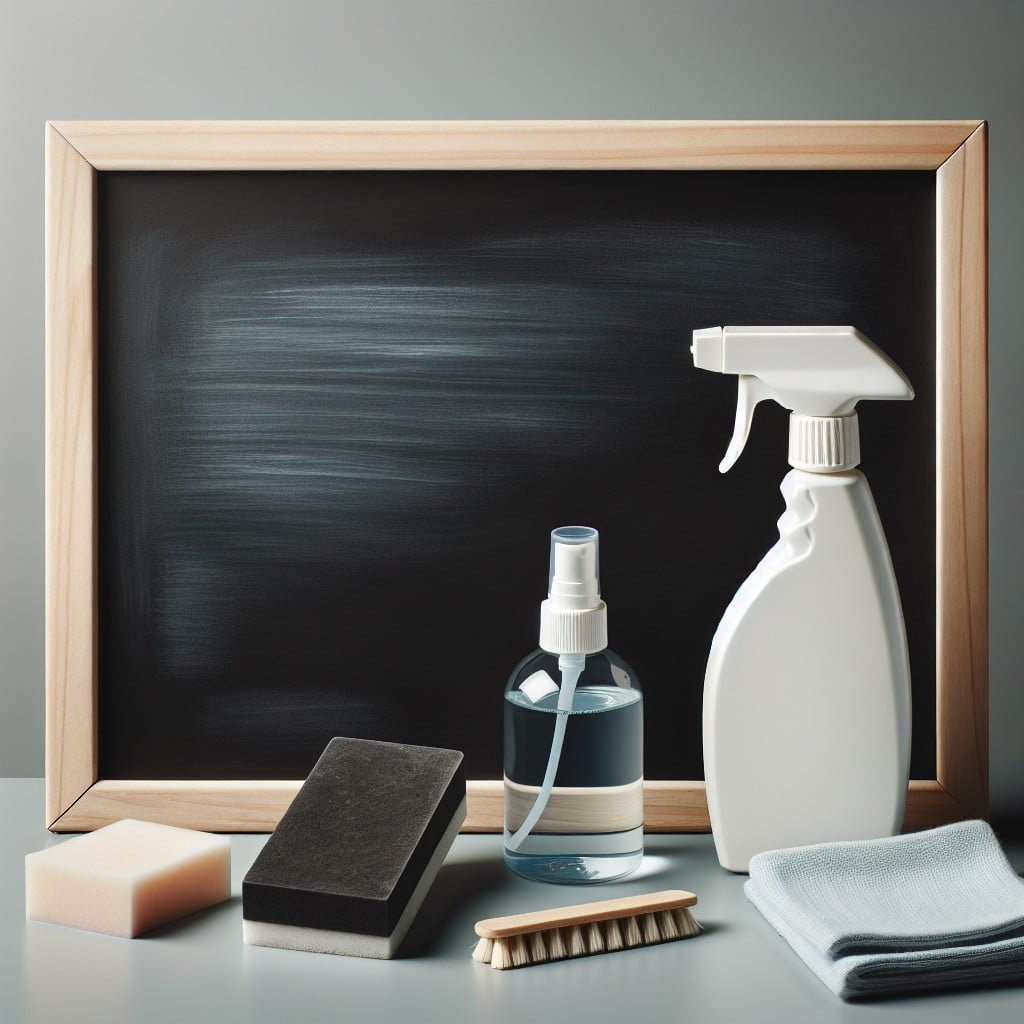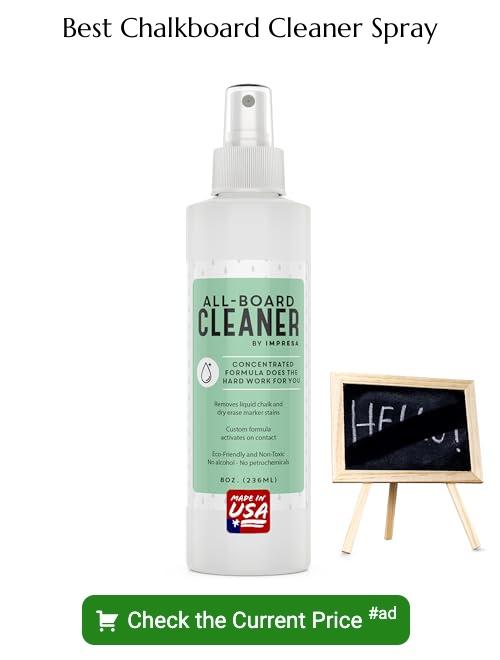Last updated on
Clearing chalk markers off a chalkboard can be quite an endeavor but proceed with the steps in this article because they are sure to streamline your cleaning process without damaging your board.
Key takeaways:
- Chalk markers are popular for their vibrancy and ease of use.
- Microfiber cloths, magic erasers, white vinegar, and isopropyl alcohol are essential for cleaning chalk markers off chalkboards.
- Specialized chalkboard cleaners or a blend of vinegar and water can be effective for removing chalk marker residue.
- Non-porous chalkboards require a different cleaning method than porous chalkboards.
- Taking proactive measures, such as choosing the right markers and regularly cleaning the chalkboard, can prevent staining and ghosting.
Understanding Chalk Markers and Chalkboard Surfaces

Chalk markers are popular for their vibrancy and ease of use when compared to traditional chalk. Designed to work on non-porous surfaces, these markers leave a smooth and bold finish that traditional dry chalk can’t match. However, they can be trickier to clean off without the right technique.
Chalkboards, meanwhile, come in two primary types: porous and non-porous. Porous chalkboards have a traditional slate surface that absorbs liquids, while non-porous chalkboards are often coated with a material like porcelain, which resists absorption. Knowing your chalkboard type is crucial as it dictates the cleaning method—what works for one could damage the other. Using the right cleaning materials, such as felt erasers for dry elimination or damp cloths and specialized sprays for wet cleaning, is also key in maintaining the integrity of both the surface and the markers’ performance.
Essential Supplies for Cleaning Chalk Markers Off Chalkboards

Ready your toolkit with the following essentials to tackle chalk marker residue effectively:
1. Microfiber cloths: These soft, lint-free cloths are gentle on chalkboard surfaces and highly effective at trapping residue without scratching.
2. Magic eraser: A magic eraser can remove stubborn stains with minimal effort, but use it with caution to avoid damaging delicate surfaces.
3. White vinegar: A natural cleaning solution that cuts through the oily residues left by chalk markers, white vinegar is both effective and eco-friendly.
4. Isopropyl alcohol: For tough stains, isopropyl alcohol can be used to dissolve marker residue without harming the chalkboard’s finish.
5. Chalkboard cleaner: Commercial chalkboard cleaners are specifically formulated to clean various types of chalkboards and may be particularly useful for challenging tasks.
6. Water: Sometimes, plain water can be sufficient for cleaning, particularly if the markers are water-based.
7. Cotton swabs: These are useful for getting into the nooks and crannies of textured chalkboards to remove all traces of marker.
Always perform a spot test with your chosen cleaning solutions and tools to ensure they don’t damage the chalkboard surface.
Recommended Chalkboard Cleaners

For optimal results, reach for specialized chalkboard cleaners designed to tackle stubborn chalk marker residue. These formulas are less harsh than traditional cleaning agents, making them suitable for maintaining the chalkboard’s integrity. If you prefer a DIY route, a blend of 50% vinegar to 50% water creates an effective natural alternative.
For quick touch-ups or to remove recent marks, a damp cloth can often do the trick without the need for cleaners. Microfiber cloths are particularly effective, as their fine fibers lift and trap pigment particles with minimal effort. For tougher stains, rubbing alcohol on a soft cloth can break down the oily residues left by some chalk markers.
Remember to use any cleaner sparingly. Applying excessive amounts can soak into a porous surface, potentially creating more issues such as warping or degradation of the board’s quality. Regular maintenance using these recommended products can keep your chalkboard clean and extend its lifespan.
Steps to Remove Chalk Marker From Non-Porous Chalkboards

Begin by wiping the area with a soft, dry cloth to remove any loose dust or residue. If the markers were recently applied, this might be sufficient to clean the surface.
For more stubborn marks, dampen a cloth with water and gently rub the board. Non-porous materials typically resist water, so a little moisture won’t harm the surface.
If the water alone doesn’t do the trick, use a mild soap solution. Dip a cloth into the soapy water, wring out excess liquid, and wipe in a circular motion.
For persistent stains, consider using a chalkboard cleaner designed for non-porous surfaces. Spray over the affected area, let it sit for a few moments, then wipe clean with a microfiber cloth.
For those harder-to-remove marks, use rubbing alcohol or a whiteboard cleaner. Apply a small amount to a cloth and rub the marks gently until they fade.
After cleaning, dry the board thoroughly with a clean cloth to avoid any water spots and to prepare the surface for future use.
If ghosting occurs—where faint traces of the markers remain—repeat the cleaning process or use a magic eraser as a last resort, being careful not to damage the surface.
Steps to Remove Chalk Marker From Porous Chalkboards
To effectively clean chalk markers from a porous chalkboard, approach the task with care to avoid damaging the surface. Start by wiping the board with a dry cloth to remove as much residue as possible without the use of liquids. If traces remain, proceed with the following steps:
1. Using Vinegar Solution: Mix equal parts of white vinegar and water. Dip a clean cloth into the mixture, wring it out well, and gently rub the stained areas. Vinegar’s mild acidity helps lift the marker residue.
2. Baking Soda for Stubborn Stains: Create a paste with baking soda and a small amount of water. Apply it to the stain and lightly rub with a soft cloth. Baking soda acts as a mild abrasive, assisting in the removal of persistent stains.
3. Rinse Thoroughly: After using any cleaning solution, it’s important to rinse the area with a clean, damp cloth to remove any leftover cleaner which could leave a residue.
4. Dry the Board: Pat the board dry with a lint-free cloth. Avoid excessive rubbing that could damage the board’s porous surface.
5. Repeat if Necessary: If any marker residue remains, repeat the cleaning steps until the surface is clear. Remember that porous surfaces can be more challenging to clean and may take a few attempts.
6. Condition the Chalkboard: Once clean, consider rubbing the surface with a chalkboard conditioner or a thin layer of chalk to prep the surface for future use.
Remember, gentle is key when dealing with porous chalkboards to maintain their integrity and ensure longevity.
Surface Matters: What Do “Porous” and “Non-Porous” Mean?
Chalkboards can be divided into two categories based on their surface type: porous and non-porous.
Porous chalkboards absorb liquids and can be made of materials like slate or wood. These boards tend to hold onto pigment, leading to potential staining or “ghosting” when you erase.
Non-porous chalkboards, on the other hand, are finished with a layer that prevents absorption. These are typically made from materials like glass or porcelain. Non-porous surfaces are smoother and less likely to retain marker residue, making them easier to clean.
Knowing the type of surface you are dealing with is crucial for effectively removing chalk marker without damaging your chalkboard.
What Is “Ghosting” of a Chalk Marker?
When a chalk marker leaves behind faint traces of the original writing even after cleaning, this is commonly referred to as “ghosting.” It occurs due to several factors:
- Surface Absorption: Porous surfaces tend to absorb pigments, making it harder to erase marks completely.
- Marker Quality: Lower-quality chalk markers may contain pigments that are more likely to cause ghosting.
- Drying Time: If marker ink is left to dry for an extended period, it may become more stubborn to remove.
- Cleaning Technique: Harsh scrubbing or using inappropriate cleaning solutions can sometimes embed the pigment further into the surface.
Understanding ghosting is crucial because it affects how you should approach cleaning and maintaining your chalkboard to keep it looking crisp and clear.
Preventing the Problem in the Future
Maintain your chalkboard’s longevity and ensure a hassle-free cleaning experience next time with these proactive measures:
1. Choosing the Right Markers: Opt for high-quality, water-based chalk markers specifically designed for the type of chalkboard you own, be it porous or non-porous.
2. Proper Application: Apply less pressure when writing to prevent the marker from seeping deep into the surface, making it easier to erase.
3. Regular Cleaning: Clean your chalkboard regularly to avoid the build-up of chalk marker residue which can become harder to remove over time.
4. Priming the Surface: If you’re using a new chalkboard or have just performed a deep clean, prime it by rubbing the side of a regular chalk piece over the entire surface and then erasing it. This provides a protective layer which can facilitate simpler cleaning.
5. Use a Sealant: On porous boards, consider using a chalkboard sealant after thorough cleaning to create a non-porous layer that guards against marker stains.
6. Follow the Directions: Always adhere to the instructions provided by the chalk marker manufacturer for both application and removal.
By implementing these strategies, cleaning off chalk markers will be smoother, helping your chalkboard stay in prime condition for its next creative endeavor.
Expert Q&A
In this segment, we tap into the expertise of seasoned professionals to address some common questions regarding chalk markers and chalkboard maintenance:
- How often should a chalkboard be cleaned to prevent staining? Experts recommend a thorough cleaning every couple of weeks with daily light cleaning after use to maintain optimal condition and prevent chalk marker residue build-up.
- Can all chalkboards handle liquid chalk markers? No. Non-porous chalkboards are best suited for liquid chalk markers, while traditional porous chalkboards might absorb the ink and stain.
- What’s the best way to test if a chalkboard is porous? Perform a spot test in an inconspicuous area using a small amount of chalk marker ink. If the ink seeps in and is difficult to erase, the board is likely porous.
- Why do some chalkboards get “ghosting” even after cleaning? Ghosting occurs when chalk marker pigments penetrate a porous surface. Frequent cleaning and using the right type of markers for your board can minimize this effect.
- Are regular classroom chalkboards and restaurant menu boards treated the same? Not necessarily. Classroom chalkboards are often porous, while many restaurant boards are designed to be non-porous to accommodate frequent menu changes.
- Is there a difference in cleaning a black vs. a green chalkboard? The color of the chalkboard does not affect the cleaning method; rather, the difference lies in whether the chalkboard is porous or non-porous.
These insights should help clarify concerns and guide best practices in using and caring for chalkboards with chalk markers.
Tips
Experiment with different brands of chalk markers to find one that cleans off easily while still providing vibrant colors.
Before applying markers to the entire surface, conduct a spot test in an inconspicuous area to check for ease of removal.
Use a high-quality chalkboard cleaner for tough stains, as it may offer a better result than household items.
Avoid using abrasive materials for cleaning to maintain the integrity of your chalkboard surface.
Regularly re-season a porous chalkboard—with a wide side of a chalk stick—covering the entire surface and then erasing to reduce future ghosting.
If markers seem to dry out and become difficult to erase, try reviving them by storing them tip-down for a while, allowing the ink to flow to the tip.
Consider keeping a cleaning kit that includes a microfiber cloth, water, vinegar, and a spray bottle handy for quick touch-ups and maintenance.
Moisten the eraser or cloth slightly for more effective cleaning, as a dry cloth may not be sufficient to remove all traces of marker.
Stay up to date with the manufacturer’s recommendations for both the chalk markers and the chalkboard you are using.
FAQ
How do you get chalk marker off a chalkboard without magic eraser?
To remove chalk marker from a chalkboard without a magic eraser, one can make use of plain dish soap and water or even opt for a glass cleaner if needed.
Can Windex clean a chalkboard?
Yes, Windex can effectively clean chalkboards.
Is vinegar an effective solution for removing chalk marker stains from a chalkboard?
Yes, vinegar is an effective solution for removing chalk marker stains from a chalkboard.
Can using a combination of soda and water eliminate chalk marker traces on a chalkboard?
Yes, a mixture of soda and water can successfully remove chalk marker traces on a chalkboard.
What are the impacts of using a chalkboard cleaner versus homemade solutions?
Chalkboard cleaners offer a more thorough clean and prevent ghosting on the surface, while homemade solutions are cheaper and eco-friendly but may leave residues behind.
Recap:





